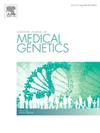Digital clubbing without hypoxia for lysinuric protein intolerance
Abstract
Digital clubbing is characterized by bulbous enlargement of the terminal segments of the fingers. Hypotheses including hypoxia have been proposed for the pathogenesis of digital clubbing, but the exact pathogenesis of digital clubbing is still uncertain. Lysinuric protein intolerance (LPI) is caused by pathogenic variants in SLC7A7 and is often associated with interstitial lung disease. Previously two patients of LPI with digital clubbing but without hypoxia have been reported. It is unclear whether digital clubbing in LPI is secondary to hypoxia or directly related to SLC7A7 deficiency. Here we report a 6-year-old Japanese boy presented with digital clubbing without hypoxia. He had episodic vomiting, each episode consisting of a single vomiting event occurring once a month, and his growth had been delayed. He had interstitial lung disease and hepatomegaly. He had compound heterozygous pathogenic variants in the SLC7A7, leading to the diagnosis of LPI. Together with the two previously reported patients mentioned above, we conclude that digital clubbing can occur in the absence of hypoxia. Digital clubbing in the absence of hypoxia has been observed in two genetic disorders related to prostaglandin (PG) E2, HPGD and SLCO2A1. PGE2 synthesis is primarily regulated by the cyclooxygenase 2, which plays a critical role in the control of inflammation. A high urine PGE level in the patient was compatible with the notion that PGE2 production may be increased in LPI. The occurrence of digital clubbing in the absence of hypoxia in LPI patients with SLC7A7 may be attributed to the mechanism of increased PGE2 production.

 求助内容:
求助内容: 应助结果提醒方式:
应助结果提醒方式:


